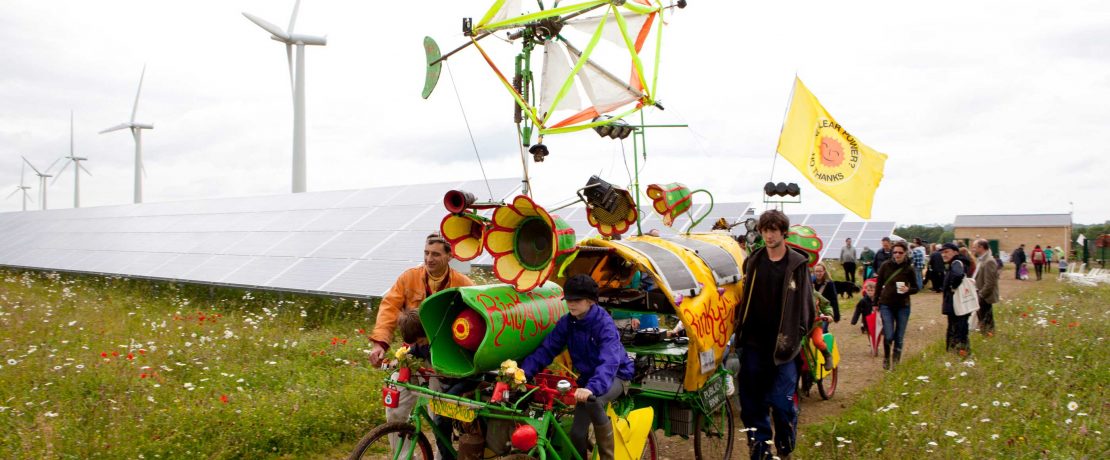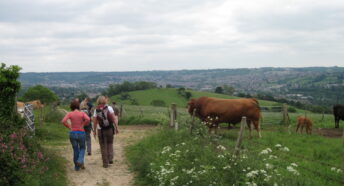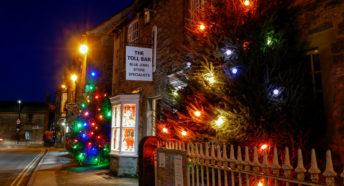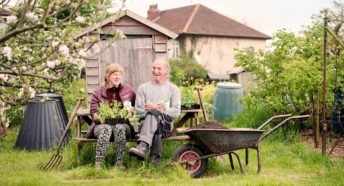10 reasons why we love community energy – for people and planet
We think that the gold standard for renewable energy done well means community energy – renewable energy projects proposed, designed, and owned by local people.
At CPRE, we know that the climate emergency threatens to damage many of our most loved landscapes and ecosystems. Places that are precious to us, like the sprawling Broads and or the wildlife-packed chalk streams of the Chilterns, could all be changed irreparably as our climate shifts.
Why we ♥ community energy
So we need to act fast to cut our greenhouse gas emissions, and to do that we need more low-carbon renewable energy. We want to see these new renewable energy projects done well, in a way that minimises impacts on landscapes, and makes sure that the rural communities who host wind turbines or solar farms get to keep the money these schemes generate.
Luckily, there are some great examples out there of community energy in action already – examples of where local people have worked together and are now reaping the benefits, as well as using energy that limits damage to the planet.
Here are our top ten real-life examples that show why community energy is the best answer to the climate emergency for thriving rural communities, and the countryside we all love.
1. It earns money for community projects
Community-run energy schemes make money which can then be used to help local people and to improve the area. A great example is Wiltshire Wildlife Community Energy; they’ve now paid a total of £45,000 into the Community Fund.
The Community Fund then makes grants to projects in the local area. For example, they’ve awarded £4,750 to Wiltshire Scrapstore, a local charity that takes resources destined for landfill and redistributes them for creative activities, to help in developing an educational space for children and families so that they can learn how to reduce their impact on the environment. The fund also gave £500 for a wildlife pond. These projects use the money from community energy to make the local area even better – what’s not to like?
2. It gives profits to locals, not corporations
Because community energy schemes are owned by local people rather than large corporations, the profit on the energy they produce doesn’t disappear into the pockets of distant speculators, but goes straight back to the people in the same rural community.
At South Dartmoor Community Energy, money made by the Portworthy Solar Array near Lee Moor village (built on brownfield land from old china clay works) is given as grants to support the local community in three parishes. Instead of becoming profits for a large commercial company, this money has supported a new community orchard, an upgraded village playground, and helped to fund a local Scout Group project.
3. It empowers and unites communities
Setting up a community energy scheme is a big undertaking and works best when it uses the skills and input of many different people from within a community. This process really brings people together and helps build the confidence of the community.
Take Ynni Ogwen in Bethesda, a community-owned hydro energy scheme in a former slate quarrying village near Snowdonia. it was set up with the involvement and contribution of people of all ages, and 85% of the members come from the local community. But the support wasn’t just financial; there was lots of local enthusiasm about volunteering for the project. Ultimately, Ynni Ogwen has been about more than just using water to generate electricity; it’s built community confidence and given local people the chance to make decisions and contribute towards the success of a shared endeavour.
4. It helps us manage our consumption
Because community energy schemes are owned and designed locally, they encourage people to consider using just the energy than their local area can produce, helping to cut demand and further reducing demand.
Eigg Electric is a community-owned company providing electricity for all residents of the Hebridean island of Eigg. It uses only renewable sources on the island, including solar panels, wind turbines and hydro energy. Residents have agreed to limit their usage to the energy that they can locally produce. To ensure that nobody goes short, each house has a maximum use limit at any one time of 5kW, and each business of 10kW. Cutting our energy use is something we can all be better at – and these residents have the perfect motivation.
5. It allows the local landscape to be protected
Designing a renewable energy scheme as a community gives local people the power to decide on the right place for a wind turbine or solar panel. This means energy infrastructure can be kept away from the most beautiful areas and sited in a place that fits in with the community. For example, the renewable installations run by Eigg electric were carefully placed to ensure they have as small an impact on the landscape as possible. Their hydro generator was located on a local burn, to have minimum visual impact. The placement of their wind turbines was also thoughtful: it has the best combination of exposure to wind with minimal turbulence, good accessibility and was the best fit in the landscape, with minimal visual impact from all directions.
6. It protects nature – by design
Community energy projects are about a lot more than just profit. They look at the bigger landscape, and so can be designed in a way that helps wildlife and actually increases biodiversity.
At Wiltshire Wildlife Community Energy Chetworth Solar Farm, the largest area of lowland neutral meadow restoration in the country, they’ve created a diverse grassland habitat in order to maximise wildlife benefits including encouraging more wildflower species.
Grassland is grazed by sheep for part of the year, with a buffer zone of tussocky grassland being developed between the outermost solar panels. There are hedgerows, providing a habitat for butterflies, reptiles, small mammals and other invertebrates and creating good foraging grounds for birds of prey including Little Owls. Birds and bats are encouraged to use surrounding hedgerows and trees for nesting and brooding. And in time, they plan to establish beehives and bug nests, so the solar farm will be a home for pollinators to enrich the surrounding farmland.
7. It helps to tackle rural fuel poverty
Community energy schemes tackle much more than the climate emergency. They can provide much-needed money for people in rural areas to insulate their homes, keeping them warm and reducing fuel costs.
As an example, Buckingham and the surrounding parishes spend almost £20 million per year on energy – almost all of which leaves the local economy. The Gawcott Fields community solar project will produce enough energy for the annual electricity consumption of a thousand homes.
Better still, the income from the solar farm has been used to fund a local energy and fuel poverty advice service called Bee Warm. The scheme offers a range of services to the local community, including grants and financial assistance for energy-saving measures such as insulation and boiler replacements.
8. It honours our rural heritage
Small-scale community energy schemes fit in with our long history of using wind and water to generate power in the countryside. Windmills and watermills have become a quintessential part of many of our rural landscapes, and the best community energy schemes simply continue and complement of this heritage.
Sandford Hydro is a renewable scheme based on the installation of three hydropower turbines on the River Thames at Sandford Lock. The lock has changed enormously over time, and the new scheme designs have sought to capture and improve upon it.
The history is remarkable. A mill was built at Sandford in 1294 by the Knights Templar, although the lock was broken during conflict between millers and bargemen during the reign of Edward III. The introduction of the hydropower scheme and replacement fish pass and sluice is just the latest incremental change at this site. The project has helped return the Lasher Weir on the Thames to its historic role as a provider of clean energy. The hydro scheme generates a huge 1.6 GWh of renewable electricity per year – the equivalent demand for 500+ households
9. It kicks off a virtuous circle of cutting carbon
The income community energy schemes provide for investing in the local area are also often used to pay for other schemes that reduce the community’s greenhouse gas emissions. So one form of decarbonisation pays for another!
Near Bristol, Low Carbon Gordano – two community-owned solar farms – provide income for a community fund that makes grants to reduce the environmental footprint of local communities. The schemes that have been supported are very exciting and varied; for example:
- Gordano School was helped to install LED lighting and increase plastic recycling in the school
- ReMission, a local organisation that supports recovering addicts, was helped to completely upgrade their heating system (with potentially major carbon savings)
- Pill and Easton-in-Gordano Parish Council received funds to accelerate their programme to convert the village street-lights to LEDs.
It’s expected that well over 50 MWh of power will be saved annually – and more than 12 tonnes of carbon dioxide.
10. It’s popular with local people
Because people in the area have so much more of a say in community energy projects than other energy schemes, they’re much more likely to be planned and designed in a way that wins approval from the community. In fact, research in Germany has found that local ownership improves net support for new wind turbines by a whopping 77%!
Westmill Wind Farm Co-Operative, pictured here, was the first in the South East of England and the first 100% community-owned scheme in the UK. The cooperative was joined by over 2000 members and has been incredibly well-integrated with the local community. Children from local schools named the turbines and the site has been opened to visitors, receiving more than 10,000 by 2015!
These turbines have been generating renewable electricity since 2008 and the fact that the local community has been so fully engaged and able to take ownership of the scheme has led to the wind farm being positively adopted by local residents.
Communities + energy = green futures
As these examples show, community energy schemes have the potential to provide huge benefits for people and nature. These projects can tackle the climate emergency by delivering clean renewable energy, ensuring a just transition to a low carbon future by putting money back in the pockets of local people and protecting our landscapes by building upon our rural heritage at the right scale and in the right places.









